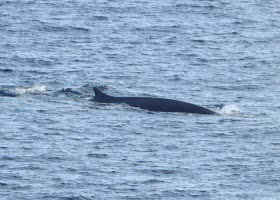
From 1 to 2 September the
ship Mega Victoria of Corsica
Sardinia Ferries hosted nine researchers involved in the project
"Life Conceptu Maris" for wildlife conservation
marina in the Mediterranean basin which is co-financed
from the European Union and proposes an innovative approach
multidisciplinary for the study of cetacean distribution and
of sea turtles in the pelagic field, which combines
Classic observation of animals from the bridge with new
technologies such as environmental DNA, stable isotopes and use
of sensors for monitoring chemical-physical parameters
of sea water.
 Scientists from ISPRA, CIMA Foundation, Stazione Zoologica AD
of Naples, Bicocca University of Milan and University
of Palermo departed from the port of Vado Ligure with destination
Bastia, Ile Rousse and Nice, on three of the routes served by the
shipping company. A team of five observers who
monitored from the bridge
flanked by four researchers who had access to the premises
Technical. A laboratory has been equipped on board the ship
research to collect water directly from the sea and to
host filtering and storage machinery for samples.
Scientists from ISPRA, CIMA Foundation, Stazione Zoologica AD
of Naples, Bicocca University of Milan and University
of Palermo departed from the port of Vado Ligure with destination
Bastia, Ile Rousse and Nice, on three of the routes served by the
shipping company. A team of five observers who
monitored from the bridge
flanked by four researchers who had access to the premises
Technical. A laboratory has been equipped on board the ship
research to collect water directly from the sea and to
host filtering and storage machinery for samples.
The information that will be obtained from this innovative
Multidisciplinary approach will be essential to build
maps of environmental characteristics, which will help
better define the distribution of cetaceans and turtles
marinas in the Mediterranean.
At the end of the six trips made, it was announced
that many fin whales have been spotted, 18 on the route
Savona/Bastia and almost 30 on the Nice/Ile Rousse route, as well as
large schools of dolphins and also the now very rare common dolphin.
In addition, incredible for this sea, 11
Caretta caretta turtle sightings during the last
crossing between Nice and Ile Rousse. There are also many sightings
of other species, including manta rays and sunfish.
'Data collected on board Corsica Ferries ferries
- underlined Paola Tepsich, researcher of Fondazione CIMA -
are confirmed every year more and more important: there are
helping to understand how species are coping with change
resulting from the warming of the sea and allow us to extend the
our analyses in otherwise inaccessible areas."